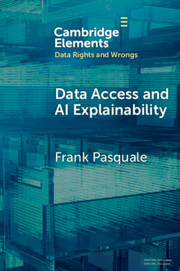Refine search
Actions for selected content:
48532 results in Computer Science
Introduction to the 41
 $^{st}$ International Conference on Logic Programming Special Issue
$^{st}$ International Conference on Logic Programming Special Issue
-
- Journal:
- Theory and Practice of Logic Programming / Volume 25 / Issue 4 / July 2025
- Published online by Cambridge University Press:
- 15 September 2025, pp. 394-401
-
- Article
-
- You have access
- Open access
- HTML
- Export citation
Uncovering policy priorities for disability inclusion: NLP and LLM approaches to analyzing CRPD state reports
-
- Journal:
- Data & Policy / Volume 7 / 2025
- Published online by Cambridge University Press:
- 15 September 2025, e61
-
- Article
-
- You have access
- Open access
- HTML
- Export citation
Checking equivalence in a non-strict language
- Part of
-
- Journal:
- Journal of Functional Programming / Volume 35 / 2025
- Published online by Cambridge University Press:
- 15 September 2025, e19
-
- Article
-
- You have access
- Open access
- HTML
- Export citation
Using graph neural networks and frequency domain data for automated operational modal analysis of populations of structures
-
- Journal:
- Data-Centric Engineering / Volume 6 / 2025
- Published online by Cambridge University Press:
- 15 September 2025, e45
-
- Article
-
- You have access
- Open access
- HTML
- Export citation
The structure of identity facilitation and interference
- Part of
-
- Journal:
- Network Science / Volume 13 / 2025
- Published online by Cambridge University Press:
- 15 September 2025, e12
-
- Article
-
- You have access
- Open access
- HTML
- Export citation
Scalable data assimilation with message passing – ARTEFACT AWARD
-
- Journal:
- Environmental Data Science / Volume 4 / 2025
- Published online by Cambridge University Press:
- 15 September 2025, e44
-
- Article
-
- You have access
- Open access
- HTML
- Export citation
Industrial mobile robot-based manufacturing system modeling potential
-
- Journal:
- Data-Centric Engineering / Volume 6 / 2025
- Published online by Cambridge University Press:
- 15 September 2025, e46
-
- Article
-
- You have access
- Open access
- HTML
- Export citation
Towards type-directed compiler calculation
- Part of
-
- Journal:
- Journal of Functional Programming / Volume 35 / 2025
- Published online by Cambridge University Press:
- 15 September 2025, e20
-
- Article
-
- You have access
- Open access
- HTML
- Export citation

Data Access and AI Explainability
-
- Published online:
- 12 September 2025
- Print publication:
- 02 October 2025
-
- Element
-
- You have access
- Open access
- HTML
- Export citation
An explicit economical additive basis
- Part of
-
- Journal:
- Combinatorics, Probability and Computing , First View
- Published online by Cambridge University Press:
- 12 September 2025, pp. 1-6
-
- Article
-
- You have access
- Open access
- HTML
- Export citation
A CASP-Based Solution for Traffic Signal Optimisation
-
- Journal:
- Theory and Practice of Logic Programming / Volume 25 / Issue 4 / July 2025
- Published online by Cambridge University Press:
- 12 September 2025, pp. 794-812
-
- Article
-
- You have access
- Open access
- HTML
- Export citation
On Systematic Construction of Correct Logic Programs
-
- Journal:
- Theory and Practice of Logic Programming / Volume 25 / Issue 4 / July 2025
- Published online by Cambridge University Press:
- 12 September 2025, pp. 631-648
-
- Article
-
- You have access
- Open access
- HTML
- Export citation
A General Framework for Dynamic MAPF Using Multi-Shot ASP and Tunnels
-
- Journal:
- Theory and Practice of Logic Programming / Volume 25 / Issue 4 / July 2025
- Published online by Cambridge University Press:
- 12 September 2025, pp. 540-557
-
- Article
-
- You have access
- Open access
- HTML
- Export citation
Finding Personalized Good-Enough Solutions to Unsatisfiable Stable Roommates Problems
-
- Journal:
- Theory and Practice of Logic Programming / Volume 25 / Issue 4 / July 2025
- Published online by Cambridge University Press:
- 12 September 2025, pp. 685-702
-
- Article
-
- You have access
- Open access
- HTML
- Export citation
Application Placement with Constraint Relaxation
-
- Journal:
- Theory and Practice of Logic Programming / Volume 25 / Issue 4 / July 2025
- Published online by Cambridge University Press:
- 12 September 2025, pp. 437-454
-
- Article
-
- You have access
- Open access
- HTML
- Export citation
ROB volume 43 issue 8 Cover and Front matter
-
- Article
-
- You have access
- Export citation
Estimating high-resolution profiles of wind speeds from a global reanalysis dataset using TabNet – ARTEFACT AWARD
-
- Journal:
- Environmental Data Science / Volume 4 / 2025
- Published online by Cambridge University Press:
- 10 September 2025, e43
-
- Article
-
- You have access
- Open access
- HTML
- Export citation
Understanding and Analysing ‘Organised Space’
-
- Journal:
- Organised Sound , First View
- Published online by Cambridge University Press:
- 10 September 2025, pp. 1-8
-
- Article
-
- You have access
- Open access
- HTML
- Export citation

Syntax and Semantics of Petri Nets
-
- Published online:
- 09 September 2025
- Print publication:
- 25 September 2025





